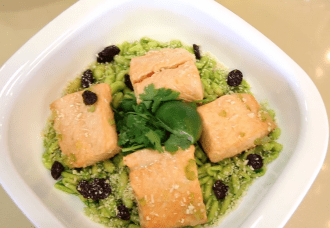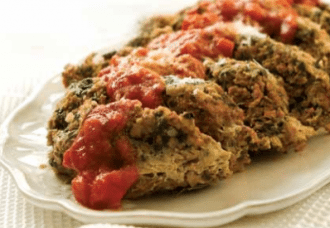Ratatouille-ism
Ratatouille is an invitation to eat vegetables gourmet-style. What can be better than that if you are a diabetic or trying to loose weight or simply wanting to eat more vegetables! It is wonderful because it is flexible – you can omit some ingredients and add your favorites, too. This originally French dish has traveled around the globe and became a staple for many cooks around the world. And of course, each confident cook adds a personal spin on the original recipe. Everyone knows what ratatouille is, even kids, especially if they watched the movie called “Ratatouille” — https://www.youtube.com/watch?v=3YG4h5GbTqU .
Here is what Wikipedia tells us about the French origin of the dish: “The word ratatouille (is related to) the verb touiller, meaning “to stir up”… From the late 18th century, in French, it merely indicated a coarse stew. The modern ratatouille – tomatoes as a foundation for sautéed garlic, onions, zucchini, eggplant, bell peppers, marjoram, fennel and basil, or bay leaf and thyme, or a mix of green herbs like herbes de Provence – does not appear in print until 1930.”
The key ingredient of ratatouille is eggplant, and diabetics are encouraged to add it to their cooking-and-eating repertoire. Here is the link that has a nice summary why eggplant is good for you — https://www.verywell.com/eggplant-carbs-and-glycemic-index-1087555 — with a couple of recipes from the author.
I could eat ratatouille every day but I also like to create a spectrum of flavors from one version to another as to not get bored. So, I will share a couple of methods on how to produce ratatouille. Let us start with basic ingredients:
- Eggplant – 3 large ones or 5-6 small ones
- Onion – 3-5 heads or the more the better
- Garlic – 1-2 heads
- Zucchini – 2-4
- Yellow squash – 2-4 (it can be used in addition to or instead of zucchini)
- Bell peppers – 1-3
- Tomatoes – 2-4
- Carrots – 2-5 (add some sweetness to the dish)
- Celery stalks – 3-5
- Celery root – 1 (optional)
- Healthy oil for cooking (grape seed or avocado) and extra virgin cold press olive oil for additional dressing after cooking
- Herbs: you can use the herbs de Provence blend or choose your favorites, dried or fresh or a combination; typically, I use what I have handy and most frequently that includes one or more of the following: cilantro, parsley, lovage, and basil. Chop the fresh herbs.
- Lemons and vinegar are optional ingredients for dressings
- Basic method: chop all the vegetables. Carrots and celery root can be shredded. Garlic can be grated or squeezed/pressed. The chopping method depends on the recipe, so choose one from those provided below. For most recipes described here, you need to chop vegetables into approximately bite-size rough cubes but keep in mind that they will cook down. For the fancy baked version, you will slice vegetables into circles — you will need a very sharp knife and/or a mandoline as well as a good company of a friend or family member who will contribute to the slicing process and make it go faster.
- I marked celery root as optional but any of the listed ingredients can be omitted if you accidently forgot to buy them or purposely want to achieve different flavors and aromas.
- Ideally, you want to sprinkle chopped eggplant with some salt and let it sit for some time: from 20 minutes to a few hours (refrigerated in the latter case) is acceptable or even overnight. This helps release eggplant’s bitterness. When ready to cook, drain the eggplant in a colander, and do NOT forget that it absorbed some salt. Use less salt in your recipe than you would otherwise. However, in my opinion, it is totally acceptable to skip this step, especially if you are pressed in time. Plus, the recipes that I provide below have many intense flavors mixed in each of them, and the fact that your eggplant is possibly slightly strong in flavor would make the dish no worse if not better. You may want to experiment with this extra step… or not.
Here are some ways that I diversify my ratatouille preparation.
Slow Stove-Top Dutch Oven Method
Use this method if you have lots of vegetables and want to make a large quantity. If you do not have a Dutch oven, use a large soup pot but be careful to not burn the bottom layer of the vegetables. Chop the vegetables that you chose into bite-size rough cubes. Heat up some cooking oil — grape seed and avocado oil are my favorites. On medium heat, sauté onion and garlic until slightly caramelized and then add the rest of the vegetables and dried herbs (if using them), add a little bit more oil and cover. Bring to a boil and turn the heat down to low. Cook until almost done with occasional stirring but do not stir too often as the vegetables will begin to break down and become too mushy. I prefer to add salt and pepper in the end along with fresh herbs. If you love garlic, you may want to add some more of it at this final stage. Taste it and adjust for salt and pepper. You may want to add some extra herbs and cayenne pepper. You can also reserve some fresh herbs for individual servings on top of the ratatouille.
Quick Sautéed Method
Use this method for a smaller amount of vegetables compared to the Dutch oven version and for faster cooking time. Start again with slightly caramelizing onions and garlic with some cooking oil. Then, add the vegetables and dried herbs and sauté first on high, then medium and then low heat until almost done. Covering the pan will help speed up the cooking. At the end, add salt, pepper, and fresh herbs.
Fancy Baked Method
For this method, I use a large pyrex glass baking tray with two-inch rims. Use a very sharp knife and/or a mandoline to slice all the vegetables (except for garlic) into thin circles. In my opinion, this is a lot of work. I reserve that for a special occasion and for when I can cook together with someone else. That way, we get to visit while chopping the ingredients and then staffing them into the baking dish.
This method requires a special note on the choice of vegetables. In order to achieve a uniform level of moisture, you will need extra onions and tomatoes. In addition to those, I typically use lots of zucchini… and nothing else, not even the eggplant. I found this combination the most appealing for my family: one of my kids listed that dish in “the favorite food” category at a school project, which made many classmates’ parents approach me – “A child’s favorite food is vegetables?! I need that recipe!” Certainly, you can slice eggplants into circles and add them, too.
Once slicing is done, spread some grape seed or avocado oil on the bottom and sides of the baking tray, sprinkle it with some salt and garlic (optional – fresh grated or chopped, or dried garlic powder). Reserve some garlic. Place vegetable slices into the tray vertically as tight as possible, filling the whole tray, by following this or similar pattern: zucchini, onion, eggplant, tomato, onion, and so on. If using no eggplant: zucchini, onion, tomato, onion, etc. Don’t be too hard on yourself during the “stuffing” process – even a messy job looks pretty and tastes wonderful. I try to fit as many chunks into the tray as I can, so it turns to be pretty tight.
When the tray is assembled, use this trick to season the dish: in a small bowl combine 3-5 table spoons of the cooking oil that you use with some salt, pepper, garlic (fresh grated or dried) and a mix of ground herbs of your choice, and stir well. If you are using dried herbs, make sure they are powdered, not whole. If your herbs are fresh, give them an extra fine chop so that they blend well in the oil. Then spread this dressing on top of the vegetables, and use your fingers to slightly “push” the herbs and spices in between the vegetable slices here and there in several areas.
Preheat the oven to 400F, and bake for about at least an hour until vegetables are tender and ready to eat (taste the onion bite to make sure it is not too crunchy; I like the vegetables to be on the soft side). If your eating plan allows for cheese, you may sprinkle some of your favorite cheese on top (lightly!), and cook the dish a little longer until cheese is melted and begins to form a crust. Personally, I prefer to use no cheese on the whole dish, but I place a bowl of good quality shredded parmesan on the dining table for those who desires to have some.
This method is certainly labor intensive, but it is worth it when you have time to spare. You will always receive some praise for it!
Simple Baked Method
Choose this method if you want to throw your vegetables in the oven while doing something else (if anything) and do the chopping after cooking. Here is what happens in my case: I open the fridge and – “Wow! I forgot all about these veges! I must cook then NOW!” In a crazy hurry, I wash these: eggplants, zucchinis, and bell peppers (can also throw in a couple of tomatoes). I rub them with grape seed or avocado oil and place them on the oven tray covered with parchment paper. No cutting and no slicing. I also like to add 1-3 heads of unpeeled garlic to the baking tray. When I have LOTS of vegetables, I use two trays and use both oven racks. Bake the vegetables in a preheated oven for about an hour at 400F. During that time you can do whatever you want without compromising the outcome.
Check for doneness with a sharp knife. Take the tray(s) out when vegetables are done and are soft. While the vegetables are cooling off, you can work on the dressing. If you want to speed up the cooling process, use tongs to move vegetables from the hot to the cold tray or plate.
If I am totally busy I choose this dressing for the dish: on the bottom of a large serving bowl (which you will serve the final dish in), mix 3-5 table spoons of olive oil, a juice of ½ or one lemon (optional; can use a splash of vinegar instead, also optional) and your favorite dried or fresh herbs and spices in desired quantity, like you would add to a salad plus some more.
If I do not mind pealing garlic and/or onion and getting out the food processor while vegetables are cooling off, I go for this dressing: on the bottom of a large serving bowl, mix one head of finely chopped onion with a juice of ½ or one lemon or a splash of white balsamic vinegar, stir well and let it sit; meanwhile, peal 3 cloves of garlic and blend it in the food processor with some salt, then add one large chopped up tomato, olive oil (at least ½ cup) and your favorite dried or fresh herbs and blend for just a few seconds and/or pulse for a few times – taste it and adjust to achieve an intense flavor as it will be diluted by the flavors of the baked vegetables; pour this mixture into the bowl and mix; adjust for salt and pepper.
When dressing is ready in the serving bowl and the vegetables are warm to touch, get them prepared as fast as you can. Typically, after cutting it in half, eggplant can be scooped with the spoon or knife out of the skin’s shell; if it is too firm to scoop (Japanese eggplant variety is like that), slice it into bite-size pieces. Chop up zucchinis. Remove seeds from the bell peppers, peel the skin if it easily comes off, and slice the peppers. If you baked tomatoes, peel the skins off and roughly chop them up. Squeeze roasted garlic out of the peels. Place all vegetables into the serving bowl with the dressing and mix. Taste and adjust for salt, pepper, herbs/spices, lemon juice and oil.
Super Fast Pressure Cooker Method
This method allows you to produce the lightest version of ratatouille as the cooking process can be done with as little oil as possible and even with no oil at all. This is very important for diabetics who are on a strict diet.
Chop the vegetables into rough cubes that are at least twice as large than bite-size. Start with onion, and place it on the bottom of the cooking bowl of your electric pressure cooker. I use Instant Pot — https://www.amazon.com/Instant-Pot-IP-DUO60-Multi-Functional-Pressure/dp/B00FLYWNYQ/ref=sr_1_2?s=kitchen&ie=UTF8&qid=1475004105&sr=1-2&keywords=instant+pot — and like it very much. If your cooker has sauté cycle, first, quickly sauté the onion with some or no cooking oil (grape seed or avocado oil). Otherwise, add all the vegetables to the bowl and sprinkle them with some salt, pepper and your favorite herbs and spices, dried or fresh. Add the required amount of water (can also use broth of your choice that is low in sodium) and cook the vegetables according to your cooker’s instructions. Be careful in following the cooling instructions as well — hot steam is very dangerous when released improperly. My Instant Pot takes only 6 minutes of cooking time plus a few minutes of cooling time. On occasion, when vegetables are too watery, the final outcome looks more like soup. In that case, I use a large slotted spoon to scoop the vegetables into the serving bowl. Adjust for salt, pepper, spices and herbs and add some olive oil, if permitted, and mix everything well. Enjoy!
What is YOUR ratatouille recipe? I would love to try it and learn new tricks. Please, share!








